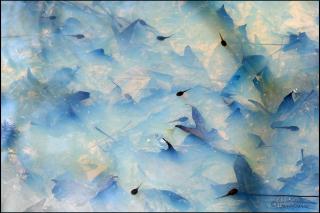Advertisement
The 2020 Spring Equinox was a heaven-on-earth kind of day in North Carolina: 70 degrees and sunny, vivid blue sky and stunning clouds. That morning, Charlotte’s local news reported the first known case of covid-19 community spread. People swarmed to the parks as if to enjoy a last day of innocence.
I was on assignment photographing people using a new greenway trail section. Paying no attention to content, I took a random close-up shot of a woodland puddle in order to lock focus before reframing the image I wanted to capture: two kids and their parents catch-and-releasing tadpoles.
Editing later, I was poised to delete the close-up but at the last second, I marked it “reject but save” instead. After meeting my client’s deadline, I returned to that rejected image and used Photoshop’s “auto-tone” tool to boost the contrast. Aside from that, it’s an unretouched image. To my staunchly photojournalistic brain, it was a ho-hum image of frog larvae in a mud puddle without much of a story to tell.
I was mildly interested in the dozen tadpoles, the submerged oak leaves, the long-leaf pine needles, the sweetgum tree spiny seed balls, the water surface rippleflections, and the decaying natural debris. But also—and oddly, for me—the photo evoked an intense emotional response that I was unable to process or describe at the time. I kept opening the image to feel it.
As the covid-19 count grew exponentially in the next weeks, we withdrew to our homes and socially distanced outside. I’m a self-employed photographer, and all my work was canceled through August. I knew that my family and I would be okay, but I woke each morning from tense dreams where people were falling over edges: environmental degradation, income disparity, and now a pandemic. With no photography jobs to edit, I left the tadpoles photo open on my second screen.
Then I began to see things in it.
First, I noticed huge jaws ready to chomp down on a tadpole. Days later I zoomed in and saw shark fins piercing the water’s surface. Later, a huge monster fish appeared on the right, eyeing its prey. On the left, serpents emerged from their lair. I saw thin snakes and bizarre, menacing creatures slinking around underwater. The tadpoles seemed directionless and frantic. Doomed. Then, finally, I saw the spiky round coronavirus entering the frame on the left.
I think this quite perfect accidental photo that I almost deleted wasn’t created by me, but it came through me. I was in the right place at the right time to convey a message from the Earth that day: “I’ve tried to warn you humans, but you haven’t listened.” Frogs are an indicator species. Their skins absorb toxins and diseases from air and water. Healthy, fertile frogs indicate a healthy habitat.
I like to think that the tadpoles in this puddle represent hope for the Earth and its people in these frightening times.
